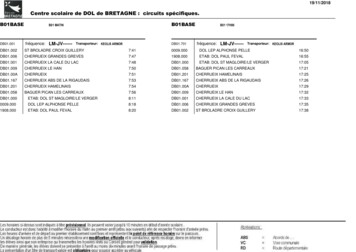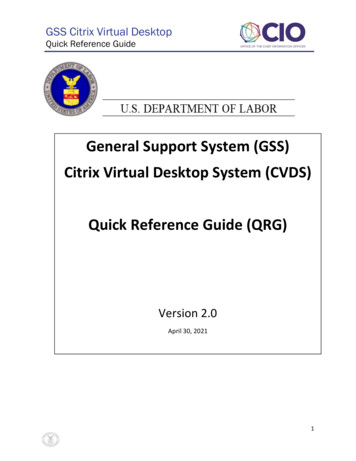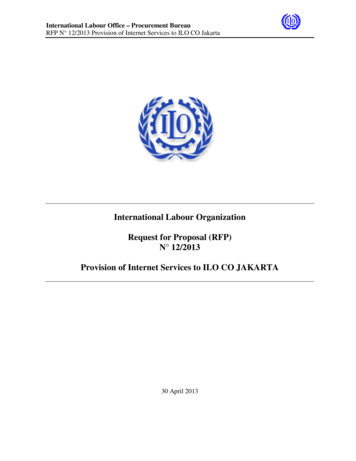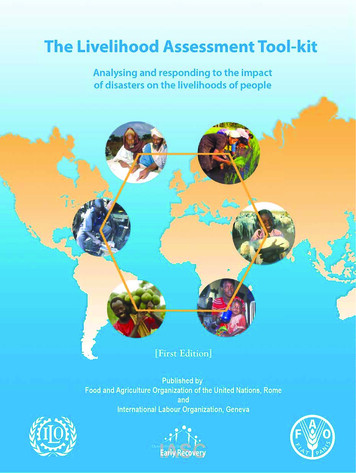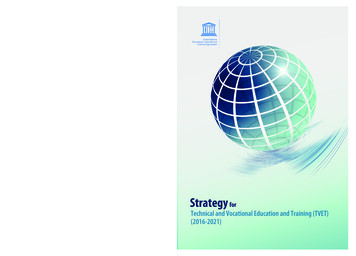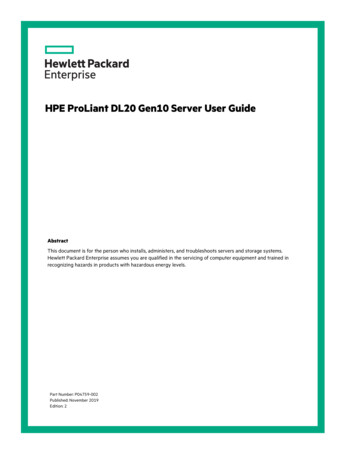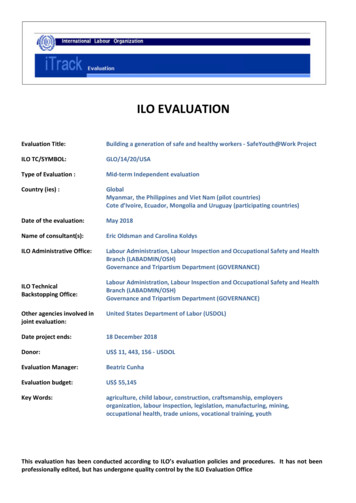
Transcription
ILO EVALUATIONEvaluation Title:Building a generation of safe and healthy workers - SafeYouth@Work ProjectILO TC/SYMBOL:GLO/14/20/USAType of Evaluation :Mid-term Independent evaluationCountry (ies) :GlobalMyanmar, the Philippines and Viet Nam (pilot countries)Cote d’Ivoire, Ecuador, Mongolia and Uruguay (participating countries)Date of the evaluation:May 2018Name of consultant(s):Eric Oldsman and Carolina KoldysILO Administrative Office:Labour Administration, Labour Inspection and Occupational Safety and HealthBranch (LABADMIN/OSH)Governance and Tripartism Department (GOVERNANCE)ILO TechnicalBackstopping Office:Labour Administration, Labour Inspection and Occupational Safety and HealthBranch (LABADMIN/OSH)Governance and Tripartism Department (GOVERNANCE)Other agencies involved injoint evaluation:United States Department of Labor (USDOL)Date project ends:18 December 2018Donor:US 11, 443, 156 - USDOLEvaluation Manager:Beatriz CunhaEvaluation budget:US 55,145Key Words:agriculture, child labour, construction, craftsmanship, employersorganization, labour inspection, legislation, manufacturing, mining,occupational health, trade unions, vocational training, youthThis evaluation has been conducted according to ILO’s evaluation policies and procedures. It has not beenprofessionally edited, but has undergone quality control by the ILO Evaluation Office
Mid-Term Evaluation ofSafe Youth@WorkProjectFinal Report –Volume 1GLO/14/20/USASubmitted byEric Oldsman, PhDNexus Associates, Inc.Carolina Koldys26 April 2018
Table of ContentsAcronyms and Abbreviations . ivExecutive Summary . 1Introduction . 6Description of SafeYouth@Work . 7Review of Project Activities . 11Principal Findings with Respect to Evaluation Criteria . 40Conclusions, Lessons learned and Recommendations. 65Volume II . 74Annex A. Terms of Reference for Mid-Term Evaluation . 75Annex B. Evaluation Criteria and Questions. 92Annex C. List of Interviews . Error! Bookmark not defined.Annex D. List of Project Documents . 93Annex E. Logical Frameworks . 100Annex F. Essentials of Occupational Safety and Health . 113Annex G. Draft Lesson Plan for OSH in 3-Month Course . 114Annex H. OSH-Related International Labor Standards . 117Annex I. OSH Courses Offered by OSHC (Philippines) . 120Annex J. Example of Training Regulations (Philippines) . 122Annex K. ILO Materials on OSH Data Collection and Use. 124Mid-Term Evaluation of the SafeYouth@Work Project – Final Reportiii
Acronyms and HEMAHRDSIAIACEH-OHIGTSSILABILSILOILO ITCILO ULIAnnual Exposure Data ReportAgriculture and Farmers' Federation MyanmarAcademy of Journalism and Communication (Vietnam)Annual Medical ReportAgence National d’Appui au Développement Rural (Cote d’Ivoire)ASEAN Occupational Safety and Health NetworkAgriculture and Farmers Federation of Myanmar (AFFM-IUF)Banana Occupational Health and Safety InitiativeBureau of Labor Relations (Philippines)Boy Scouts of the PhilippinesBureau of Working Conditions (Philippines)Building and Wood Workers Federation of MyanmarCordillera Administrative Region (Philippines)Cote d’IvoireConsejo de Educación Técnico Profesional Universidad del Trabajo de UruguayInter-American Center for Knowledge Development in Vocational TrainingComprehensive Monitoring and Evaluation PlanNational Tripartite Occupational Safety and Health Council (Uruguay)Country programme outcomesChief technical advisorNational Tripartite OSH Committee (Cote d’Ivoire)Confederation of Trade Unions of MyanmarDepartment of Agriculture (Myanmar)Department of Health (Philippines)Department of Labor and Employment (Philippines)Department of Labor, Invalids and Social Affairs (Vietnam)Decent Work Country ProgrammesDepartment of Work Safety (Vietnam)Decent Work TeamEmployees Compensation Commission (Philippines)Employers’ Confederation of the PhilippinesEmployees’ Compensation Program (Philippines)Employee injury insuranceFood and Agriculture OrganizationFriedrich-Ebert-StiftungFactories and General Labor Laws Inspection Department (Myanmar)Financial Integrated Systems for External OfficesGeneral Agency for Specialized Inspection (Mongolia)General Department of Vocational Training (Vietnam)Government Financial Institution (Philippines)Deutsche Gesellschaft fur Internationale Zusammenarbeit (GIZ) GmbHGovernment Owned and Controlled Corporations (Philippines)General Statistics Office (Vietnam)Health Environment Management Agency (Vietnam)Human Resource Development Service (Philippines)Implementation AgreementInter-Agency Committee on Environment Health-Taskforce on Occupational Health (Philippines)General Inspectorate of Labor and Social Security (Uruguay)Bureau of International Labor AffairsInstitute of Labor Studies (Philippines)International Labour OrganizationILO International Training CenterWork Improvement in Neighborhood Development ProgrammeILO Regional Office for Asia and the PacificNational Institute of Employment and Professional Formation (Uruguay)International Programme on the Elimination of Child LabourInformation Resource Integrated SystemsIndustrial Safety Techniques and Environmental Agency, Ministry of Industry and Trade of VietnamIndustrial Training Center (Vietnam)Industrial Workers’ Federation of MyanmarKnowledge, Attitude and BehaviourLabor AdministrationLocal Government Units (Philippines)Labor InspectionMid-Term Evaluation of the SafeYouth@Work Project – Final Reportiv
r Law Compliance Officers (Philippines)Labor Law Compliance System (Philippines)Letter of AgreementMyanmar Construction Entrepreneurs AssociationMyanmar Industries Craft and Services Unions FederationManagement information systemMinistry of Agriculture, Livestock and Irrigation (Myanmar)Ministry of Construction (Vietnam)Ministry of Health (Vietnam)Ministry of Industry and Trade (Vietnam)Myanmar Ministry of Labor, Immigration and PopulationMinistry of Labor, Invalids and Social Affairs (Vietnam)Micro, Small and Medium EnterprisesMid-term evaluationMyanmar Transport and Logistics FederationMining Workers’ Federation of MyanmarNational Capital Region (Philippines)National Institute of Occupational and Environmental Health (Vietnam)National OSH ProfileNational project coordinatorNational Statistical Office of MongoliaNational qualification frameworksOffice of Child Labor, Forced Labor and Human TraffickingOccupational safety and healthOccupational Safety and Health Center (Philippines)Occupational Safety and Health (OSH) Global Action for PreventionProgramme and BudgetsProject Consultative CommitteeProvision for Cost IncreasePhilippine Information AgencyPeople Managers Association of the PhilippinesProgramme OfficerPersonal Protective EquipmentProject Steering Committee or Program Support CostRegular budgetRegular budget supplementary accountRegional Office for Asia and the Pacific (mentioned before as ILO-ROAP)Regional Tripartite Industrial Peace Councils (Philippines)State Agricultural Institutes (Myanmar)Sustainable Development GoalsSmall and medium-sized enterpriseStatement of WorkStrategic sector cooperationStart and Improve Your BusinessSafe Youth at WorkTechnical Education and Skills Development Authority (Philippines)Terms of ReferenceTraining of TrainersTechnical Progress ReportsTrade unionTechnical Vocational and Education TrainingTechnical Working Group (Philippines)University of Labor and Social Affairs (Vietnam)Union of Myanmar Federation of Chambers of Commerce and IndustryCollege of Public Health at the University in Manila (Philippines)U.S. Department of LaborVietnam Chamber of Commerce and IndustryVietnam Cooperative AllianceVietnam Farmers’ UnionVietnam General Confederation of LaborVietnam Occupational Safety and Health AssociationVision Zero FundWork Accident and Illnesses ReportWorld Congresses on Safety and Health at WorkWorld Health OrganizationExtra-budgetary resources for technical cooperationMid-Term Evaluation of the SafeYouth@Work Project – Final Reportv
Executive SummaryIntroductionBackground1.With funding provided by the US Department of Labor, 1 the ILO launched a four-year, US 10.4million project in December 2014 – Building a Generation of Safe and Healthy Workers(GLO/14/20/USA). 2 On 24 November 2015, USDOL approved a modification to the cooperativeagreement, bringing the total budget to roughly US 11.4 million.2.Recognizing their greater vulnerability to work-related injury and illness, the SafeYouth@Workproject aims at improving the occupation safety and health of young workers (15 to 24) andpromoting a culture of prevention. To this end, the project has established four “immediate”objectives: i) comprehensive, relevant and quality data and information on occupational safety andhealth of young workers are available for effective use in selected countries; ii) national legislation,regulations, policies and programs are improved in order to better address the safety and health ofyoung workers; iii) national capacities to monitor and enforce OSH laws and regulations,particularly those relevant to young workers, are enhanced; and iv) global knowledge andawareness of particular hazards and risks faced by young workers is increased.3.The project is designed to operate in three “pilot” countries – Myanmar, Philippines, and Vietnam –and five “participating” countries— Cote d’Ivoire, Ecuador, Mongolia, Indonesia, Uruguay. 3Interventions in the different countries cover a wide range of activities, including working withtripartite constituents in selected countries to prepare National OSH Profiles and Action Plans;strengthen OSH legislation and regulations in line with relevant ILO Conventions; improve nationalOSH data including recording and notification systems; enhance capacity of inspectors and socialpartners to increase OSH compliance; mainstream OSH into vocational education and training; andraise awareness of OSH among young workers and the broader society through communicationcampaigns. Interventions in selected countries are intended to inform and be reinforced byglobal/regional activities including research on OSH issues related to young workers andparticipation in initiatives such as ASEAN Occupational Safety and Health Network (ASEANOSHNET), World Congress on Safety and Health at Work, Child Labor Conference, and InternationalSafe Work Day.Purpose and scope of the evaluation4.The purpose of the mid-term evaluation (MTE) is to provide an objective assessment of the designand implementation of the Safe Youth at Work (SY@W) project from its inception through midDecember 2017 in order to gauge results and inform future actions. As specified in the Terms ofReference (TOR), the evaluation centers on a review of the strategy adopted by the project toaccomplish stated objectives and an assessment of the progress that has been made to date. Itaddresses a series of questions related to six evaluation criteria: relevance, coherence, efficiencyUSDOL funding is managed through the Office of Child Labor, Forced Labor and Human Trafficking (OCFT) within the Bureau ofInternational Labor Affairs (ILAB).2 The title of the project has been shortened to SafeYouth@Work (SY@W).3 The Project Document approved on 16 Jul 2015 calls for implementing “comprehensive intervention frameworks” in the threepilot countries that address all four immediate objectives with particular attention paid to one or more sectors such asagriculture, manufacturing, construction and mining. It was intended that good practices in the pilot countries would serve as a“model” for replication in more narrowly focused interventions in “approximately eight” other participating countries.1Mid-Term Evaluation of the SafeYouth@Work Project – Final Report1
(including project management), effectiveness, sustainability, and impact. Based on this analysis,the evaluation highlights lessons and offers recommendations for ILO to consider as it movesforward with the project during the remainder of the funding period.Evaluation methodology5.The evaluation is based on qualitative research, drawing on key informant interviews, writtenresponses to questions posed by the evaluation team, in-depth review of project files, andsecondary sources. 4,5 Key informant interviews included SY@W and other ILO staff who have beeninvolved with the program as well as tripartite constituents in Myanmar, Philippines and Vietnam.Missions to the three pilot countries were conducted between 26 Nov and 17 Dec 2017. Additionaltelephone interviews were conducted with country directors and program officers in participatingcountries as well as representatives of USDOL. The principle audience for the mid-term evaluationconsists of the USDOL, ILO management, SY@W project staff, and national tripartite constituents.Conclusions and lessons learnedConclusions6.Conclusions with respect to each of the evaluation criteria are summarized below: Relevance. As informed by relevant international labor standards, the SY@W project is alignedwith the ILO strategic framework and policy outcomes that focus on ensuring the safety andhealth of workers. Morever, the SY@W project has been largely aligned with the needs of theselected countries. Tripartite constituents acknowledge the need to strengthen OSH andappreciate the greater vulnerability of young workers. While there is general support forSY@W, the strength and breadth of commitment varies. Other ILO projects and internationalorganizations are also working on similar issues, albeit not with an orientation specificallytoward young workers. The SY@W project is intended to build on and/or complement theseother initiatives. In this regard, most SY@W activities center on the kinds of engagements thatLABADMIN/OSH, LABOUR LAW and other branches have supported for years – development ofOSH laws and regulations, development of National OSH Profiles and Programs, and capacitybuilding of labor inspectorates and social partners; however, the SY@W project is trying to bringa greater focus on addressing the particular needs of young workers, including, but not limitedto, through changes in laws and regulations to provide adequate safeguards for young workers,changes in how OSH data are collected and analysed to provide a better picture of the problemsfacing young workers, changes in how labor inspectors and social partners are trained to ensurethat they are able to identify and address issues that affect young workers, changes in howyoung workers are trained in schools and workplaces; and changes in the design and content ofOSH awareness campaigns that target young workers. In some instances, the ability to effectneeded changes, is contingent on addressing broader OSH policy or a wider set of functions orsystems with particular institutions that deal with all workers. The challenge is where to set theboundaries for a project with a development objective that explicitly focuses on young workers(ages 15-24) given limited staff resources, budget and time. The integration of OSH into TVET isa new activitity for LABADMIN/OSH; while OSH is reflected in national qualification frameworksadopted in some countries, there are significant implementation challenges with respect to thedevelopment of lesson plans and competency exams, teacher training and certification,45A list of the interviews is included in Annex C.A list of project documents is included in Annex D.Mid-Term Evaluation of the SafeYouth@Work Project – Final Report2
adequacy of facilities and equipment, and institutional compliance audits. Finally, some plannedactivities such as developing rating systems for employment injury insurance schemes are notgermane to the central aim of the project and are not aligned with the particular expertise ofLABADMIN/OSH. Coherence. As stated, the relationships among the four immediate objectives and the overalldevelopment objective is sound; however, the links between some activities and objectives areweak and the overall scope of the project is overly ambitous. In a number of instances, theachievement of objectives is dependent on actions outside the control of the project or deemedto be beyond the project’s scope. With respect to the latter, the role of SY@W inimplementation is sometimes not well defined. Moreover, particularly with respect to legalreforms and capacity bulding of labor inspectorates and social partners, SY@W has not yetarticulated an approach, materials, or tools that can be used to help address the particularneeds of young workers. Although most activities thus far have been carried out in anappropriate sequence, on occasion activities have been undertaken prior to the completion ofantecedents. While members of different ILO project teams in particular countries regularlyinteract, actual coordination of OSH-related projects has been challenging given differentobjectives, schedules, and sectoral/geographical focus. Coordination with projects managed byother international organziations has also been difficult at times. Finally, while discussed in theProject Document, SY@W has not yet addressed OSH-related gender or inclusion issues intraining or other activities. Effectiveness. Project activities have faced significant delays due to various factors, including thetime required to bring a CTA on board and prepare a Project Document and related SOWs;turnover of NPCs in the Philippines and Vietnam; the lack of field staff in participating countries;time required to develop and approve TORs and implementation agreements; difficulty inrecruiting national consultants; competing demands on staff time; and the time required forgovernment decision and/or action. Many planned activities in pilot and participating countrieshave not yet started. Delays in project implementation have hindered the achievement ofobjectives. While there has been some progress on raising awareness of the vulnerability ofyoung workers among certain constituents, major public awareness campaigns have yet to bemounted. Progress on effecting policy and legal reforms has been limited as has enhancingnational capacities to monitor and enforce OSH laws and regulations. There has been virtuallyno progress in strengthening the collection and use of OSH data, including OSH recording andnotification systems. Efficiency. Through October 2017, roughly US 5.5 million had been spent on the project,accounting for roughly half of the total available budget. Limitations with ILO financial systemspreclude a comprehensive analysis of budget and expenditures by objective. That said, datashow that roughly US 400,000 has been spent on external collaborators across all fourimmediate objectives; in comparison, US 700,000 was spent at the global level, includingUS 373,000 for the SafeYouth@Work Congress in Singapore (3-6 Sep 2017) and US 287,000 forthe KAB survey. The review identified areas where project management warrants improvement,including quality assurance and technical backstopping, utilization of materials and toolsdeveloped by ILO and other parties, responsiveness of Geneva to requests from the field, andmonitoring and evaluation. Sustainability. Given limited progress on achieving results so far, sustainability after the projectends is far from certain. That said, SY@W has already increased awareness of the importance ofaddressing the needs of young workers among some policymakers, members of civil society andthe general public in the three pilot countries. Greater awareness may lead to changes inattitudes and behaviour that persist after the project ends. Moreover, many organizations haveMid-Term Evaluation of the SafeYouth@Work Project – Final Report3
expressed a commitment to address the needs of young workers. In this regard, two pointsmerit highlighting. First, given the ratification of ILO labor standards, governments have anobligation to establish a requisite legal framework to protect the safety and health of allworkers, including young workers (ages 15-24). Legislation and regulations enacted with theassistance of the SY@W, as in Vietnam, are likely to remain in force, albeit laws are alwayssubject to repeal or amendment. Second, the willingness and ability to devote resourcesneeded to implement policies and maintain programs over time varies across organizations. Insome instances, organizations are fully prepared to continue initiatives after the project ends.These institutions are obligated to undertake activities by law and/or see these initiatives as partof their core mission and have the requisite financial and human resources to carry them out.However, as noted above, some government agencies and social partners report that they donot have resources available to implement awareness campaigns, build institutional capacities,or conduct training programs. With respect to the latter, plans to roll out most trainingdeveloped under the auspices of the projects after the completion of TOT and SY@W-supportedpilot initiatives have not yet been established. The cost of providing services has not beenestimated, nor has a strategy for covering costs through a combination of government grants,membership dues and/or fees-for service been developed. In some cases, social partners haveindicated they simply do not want to assume responsibility for training. Impact. Given the current project design and the limited progress to date, it is unlikely thatSY@W will yield significant improvements in the safety and health of young workers or result ina culture of prevention in any of the eight selected countries by the scheduled end of theproject in December 2018.Lessons learned7.There are several lessons that can be distilled from the results of the evaluation that haveimplications for ILO (and potentially other organizations) going forward: Sufficient staffing and the provision of adequate oversight are critical. Projects need to be tailored to conditions within each country, recognizing the specific politicalsituation and capacity of existing institutions. The commitment of implementing partners is key, extending beyond ministries of labor. ILO and donors need to be prepared to work in a country over a long period of time; efforts toeffect major changes in policy, institutions, and culture are likely to take more than four years.Recommendations8.The results of the evaluation lead to eight recommendations organized under two main headings:strategy and operations. The recommendations are applicable to SY@W global and all countriesthat are currently involved in the project. Responsibility for implementing recommendations restswith the SY@W, Country Offices, and LABADMIN/OSH.Strategy Recommendation 1: Narrow the project scope, placing greater emphasis on activities that arelikely to have a direct and more immediate impact on the safety and health of young workers.ResponsibilitySY@W and Country OfficesPriorityHighTime ImplicationShort-termMid-Term Evaluation of the SafeYouth@Work Project – Final ReportResource ImplicationLow4
Recommendation 2. Consolidate the number of countries involved in the project.ResponsibilitySY@W and Country OfficesPriorityHighTime ImplicationShort-termResource ImplicationLow Recommendation 3. Place greater emphasis on non-regulatory mechanisms to reinforcecompliance with OSH regulation, including more active community engagement and the use ofgovernment procurement.ResponsibilitySY@W and Country OfficesPriorityHighTime ImplicationShort-termResource ImplicationMedium Recommendation 4. Reassess partnerships with implementing agencies, paying particularattention to their willingness and ability to commit requisite resources.ResponsibilityPriorityTime ImplicationResource ImplicationSY@W and Country OfficesHighShort-termLowOperationsRecommendation 5. Develop standard training packages for young workers in targeted sectorsas well as materials for awareness campaigns, which can be used across countries.ResponsibilitySY@W and LABADMIN/OSHPriorityHighTime ImplicationShort-termResource ImplicationMedium Recommendation 6. Develop joint work plans for all OSH-related projects in countries.ResponsibilitySY@W and Country OfficesPriorityHighTime ImplicationShort-termResource ImplicationLow Recommendation 7. Review policies and procedures for recruiting consultants.ResponsibilitySY@W and LABADMIN/OSHPriorityHighTime ImplicationShort-termResource ImplicationHigh Recommendation 8. Strengthen technical backstopping.ResponsibilitySY@W and LABADMIN/OSH Time ImplicationShort-termResource ImplicationHighRecommendation 9. Strengthen monitoring and evaluation.ResponsibilitySY@W and LABADMIN/OSH9.PriorityHighPriorityHighTime ImplicationShort-termResource ImplicationLowIn light of the above, the SOW for the global program and relevant countries, work plan and budgetfor the remainder of the funding period will need to be reformulated at the global level as well asfor each country. This needs to be done as soon as possible.Mid-Term Evaluation of the SafeYouth@Work Project – Final Report5
IntroductionPurpose and scope of the evaluation10. The mid-term evaluation (MTE) is intended to provide an objective assessment of the design andimplementation of the Safe Youth at Work (SY@W) project from its inception on 19 December 2014through mid-December 2017 in order to gauge results and inform future actions. 6,7,811. As specified in the Terms of Reference (TOR), the specific objectives of the MTE are as follows: “(i)review the continued relevance and usefulness of the intervention models designed for thestakeholders and beneficiaries; (ii) assess the progress made to date towards achieving the plannedglobal and country-level results and identify any constraints hindering the achievement of theseobjectives; (iii) identify unexpected positive and negative results due to the project interventions;(iv) examine delivery of project outputs in terms of quality, quantity and timing and suggest whatcan be done to improve project performance and results; (v) analyse the efficiency of the project indelivering services and products at global and country levels; (vi) assess the potential impact of theproject on the beneficiaries (i.e. young workers and related stakeholders); (vii) review thesustainability strategy of the project and the likelihood that it might happen; (viii) proposerecommendations for improved effectiveness and performance; and (ix) identify emergingpotential good practices and consider lessons learned so far.” 9Evaluation methodology12. The principle audience for the mid-term evaluation consists of the USDOL, ILO management, SY@Wproject staff, and national tripartite constituents. The evaluation addresses a series of questionsrelated to six evaluation criteria as defined in Table 1. 10Table 1. Evaluation CriteriaCriteriaRelevance andstrategic fitDefinitionThe extent to which the objective of promoting the safety and health of young workers is consistent with ILOpolicy, the decent work agenda, and constituent needs and priorities.Coherence(Validity)Efficiency (a)The extent to which the strategy adopted by the SY@W project has been logical and consistent, focusing onactivities for which the ILO is best suited.The extent to which resources available to the SY@W project have been used to generate results at the leastcost.The extent to which planned activities for the SY@W project have been undertaken, outputs have beenproduced, and the immediate objectives have been achieved.The likelihood of achieving the development objective of the SY@W project – improved safety and health ofyoung workers (ages 15-24) and a culture of prevention developed in selected countries.The likelihood that any changes brought about by the SY@W project, particularly in pilot and participatingcountries, will persist after the project ends and result in lasting improvements in the safety and health ofyoung workers (ages 15-24).EffectivenessImpactSustainabilityIn accordance with the ILO Evaluation Policy and procedures, all development cooperation programs and projects with abudget over US 5 million must undertake an initial monitoring and evaluation appraisal, a midterm and a final independentevaluation. USDOL’s Management and Procedures Guidelines also require external mid-
AFFM Agriculture and Farmers' Federation Myanmar AJC Academy of Journalism and Communication (Vietnam) AMR Annual Medical Report ANADER Agence National d'Appui au Développement Rural (Cote d'Ivoire) ASEAN-OSHNET ASEAN Occupational Safety and Health Network AUTM-IUF Agriculture and Farmers Federation of Myanmar (AFFM-IUF)
